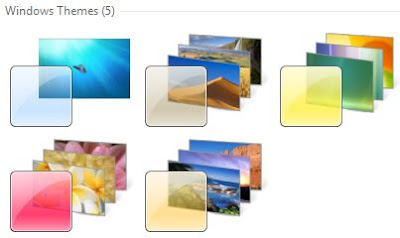
12 June 2010
Enable hidden built in administrator account in Windows Vista

02 June 2010
Access Hidden Themes & Wallpapers in Windows 7

Here are The Steps..
1. In the search box in the Start menu, type
"C:\Windows\Globalization\MCT "
and press Enter. (Note: If Windows 7 is installed in a drive other than C:, use the respective drive letter instead.)
2. Windows Explorer will launch and show you a list of subfolders
3. Under C:\Windows\Globalization\MCT: you can see some folders like MCT-AU, MCT-CA, MCT-GB, MCT-US, and MCT-ZA. Each subfolder has wallpapers for a specific country
AU for Australia, CA for Canada, GB for Great Britain, US for the United States, and ZA for South Africa.
* For any of the countries whose wallpaper and themes you want to use, go into its Theme folder, for example, C:\Windows\Globalization\MCT\MCT-ZA\Theme.
* Double-click the theme you see there (for example ZA).
* That will install a shortcut to the theme and wallpapers in the Personalization section of Control Panel.
You can now use them as you would any other theme or background, by right-clicking the desktop, choosing Personalize, and choosing a background or theme. They will be listed in their own section.
Why these thing are locked...
When you first install Windows 7, it asks for your language, time and currency. Based on your responses, it installs a set of wallpapers and themes. If you choose English (United States) for your time and currency format, for example, the available desktop backgrounds and themes will include a United States section with scenery from locations such as Maine, the Southwest and so on. so for each specific location seperate themes get installed...
01 June 2010
Restore Quick Launch bar in Windows 7

Windows 7 has upgraded the Quick launch bar into a new taskbar functions as a program launcher as well as task switcher. So the old Quick Launch bar on the left side of the taskbar that contained shortcuts for frequently used programs, has been Vanished. However, if you really intend to regain that functionality, you can add it back.
Here are the steps..
* Right-click the task bar and choose Toolbars --> New Toolbar.
* You'll be asked to select a folder for where the new toolbar should live. In the Folder text box at the bottom of the dialog box, enter this text:
"%userprofile%\AppData\Roaming\Microsoft\Internet Explorer\Quick Launch"
* After you do that, click Select Folder.
* A link for the Quick Launch bar will be added to the taskbar.
* It will be on the right of the taskbar, just to the left of the Notification area.
It's not particularly docked all the way to the right with no application icons showing, so we're going to have to do a bit of work on it to make it useful.
* Right-click the task bar
* In the pop-up menu remove the check next to "Lock the task bar"
* Now right-click Quick Launch and remove the checks next to Show Text and Show Title.
Once you've done it, drag the vertical triple dotted line next to the Quick Launch bar to the left until you expose its icons. To prevent further changes, right-click the taskbar and check Lock the taskbar. You can now use the Quick Launch bar as you could in Windows XP and Vista, including adding icons to it and deleting them.